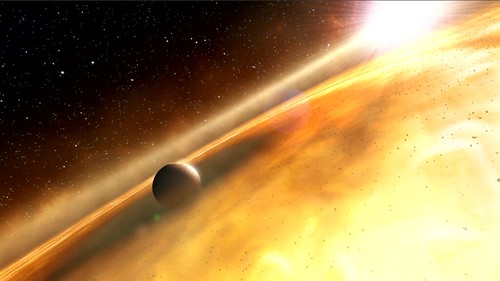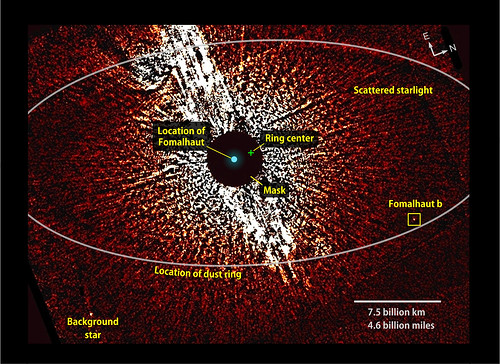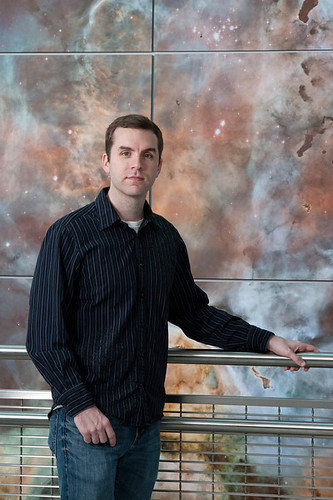The Strange Case of “Zombie” Planet Fomalhaut b
- By Sara Mitchell
- November 26, 2012
- Comments Off on The Strange Case of “Zombie” Planet Fomalhaut b
The timing couldn’t have been more perfect – just days before Halloween, NASA released a story about a planet that had returned from the dead. The exoplanet, Fomalhaut b, was discovered in 2008 using data from the Hubble Space Telescope. More recently, other researchers suspected it might be a dust cloud instead, so its planetary status was revoked. However, even newer research has caused astrophysicists to reverse the decision once again – Fomalhaut b is a planet once more!
How did this happen? What makes Fomalhaut b so tricky to interpret? We wanted to go right to the source, so we got in touch with the head of the team that helped bring this planet back from the dead. Dr. Thayne Currie is a recent NASA Postdoctoral Fellow at Goddard Space Flight Center and is currently in the Department of Astronomy and Astrophysics at the University of Toronto.
Blueshift: Can you tell us a little bit about yourself? What is the focus of your research at Goddard?
Thayne Currie: My focus at Goddard was primarly to look for new planets via direct imaging and better characterize the properties (atmospheres, orbits) of known directly imaged planets. I also did some research studying planet formation and planet-forming disks via infrared photometry and spectroscopy.
Blueshift: Can you tell us a bit about Fomalhaut and Fomalhaut b?
Thayne: Fomalhaut is a nearby A star (about twice the Sun’s mass) long known to be surrounded by a disk of dust somewhat analogous to our own Kuiper belt. About seven years ago, we were able to image this disk for the first time in scattered light (using the Hubble Space Telescope)and identified what we thought was a clear signature of an embedded planet: the fact that the disk center is offset from the star’s position.
Fomalhaut b was first reported in Hubble data in a paper published in 2008 and was claimed to be the first exoplanet ever imaged in visible light.
Blueshift: What made you revisit Fomalhaut b?
Thayne: Since the original discovery paper, follow-up studies looking at this system using different instruments/telescopes began to cast doubt upon Fomalhaut b being a planet. Previously, I had obtained my own Fomalhaut data that I thought might be able to tell us something about the kind of planet (if it is a planet) that Fomalhaut b is. Also, we had developed image processing tools that would better help us separate out the star’s light from the light of a planet. Clearly, it is important to know whether the first reported exoplanet imaged in visible light is a bona fide result, whether the original claim was a mistake, etc.

Credit: ESA/Hubble (M. Kornmesser) and ESO (L. Calçada & L. L. Christensen)
Blueshift: How do you know that something you’ve observed is a planet?
Thayne: Good question, typically you need to first establish that the object you are seeing is bound to the star, not a background object. Ideally then, you can compare the brightness of this object to the brightnesses of other low-mass objects called brown dwarfs and to model predictions that map between brightness and the mass of a substellar object (a planet or brown dwarf, where the dividing like is about 13 to 15 times Jupiter’s mass). We can also use other methods to determine upper limits to the mass of the planet. For example, if the star has been targeted by the radial-velocity method, we can use upper limits on the Doppler shift of this planet induced on the star to constrain its mass. If the system in question is a multi-planet system, we can use dynamical stability tests to constrain the masses of the planets.
In the case of Fomalhaut b, we don’t really know for sure since the emission that is identifying Fomalhaut b cannot come from the atmosphere of a planet. The IR non detections limit Fomalhaut b’s mass to be less than about twice Jupiter’s mass. If Fomalhaut b is a planet sculpting the debris ring, it probably must be at least Neptune’s mass with the most current models favoring about half Jupiter’s mass. If there is a planet there, it is surrounded by small dust, which is what is producing our detections.

Credit: NASA/ESA/T. Currie (U. Toronto)
Blueshift: What is it about this system that has made the status of the planet difficult to ascertain? Why has there been disagreement about the
parameters and interpretation of this system?
Thayne: Well, unlike the other system announced on the same day (HR 8799 bcd… and later e), we do not detect Fomalhaut b in the infrared in follow-up observations, whereas young planets are supposed to be far brighter and easier to see in the infrared. There were also some problems in the discovery paper itself. The object is only detected in the optical and its spectrum does not look like that of any planet in from any model. Fomalhaut b was moving too fast to be a planet responsible for sculpting the debris ring. It also had a strange variability at about 0.6 microns that was originally attributed to gas accretion onto the planet, yet the system is far, far older than the age at which this process should be occurring.
Blueshift: What’s next for your research?
Thayne: I have my own program to characterize the orbits and atmospheres of other directly imaged planets – HR 8799 bcde and beta Pic b – and to search for new ones using the Keck and Gemini telescopes. I am also heavily involved with a large program using the Subaru telescope called “SEEDS” and with a new, state-of-the-art planet imaging system on Subaru called SCExAO (Subaru Coronagraphic Extreme Adaptive Optics).
Blueshift: Is it just me, or does Fomalhaut look like the Eye of Sauron in that Hubble image?
Thayne: Yes, indeed it does!




